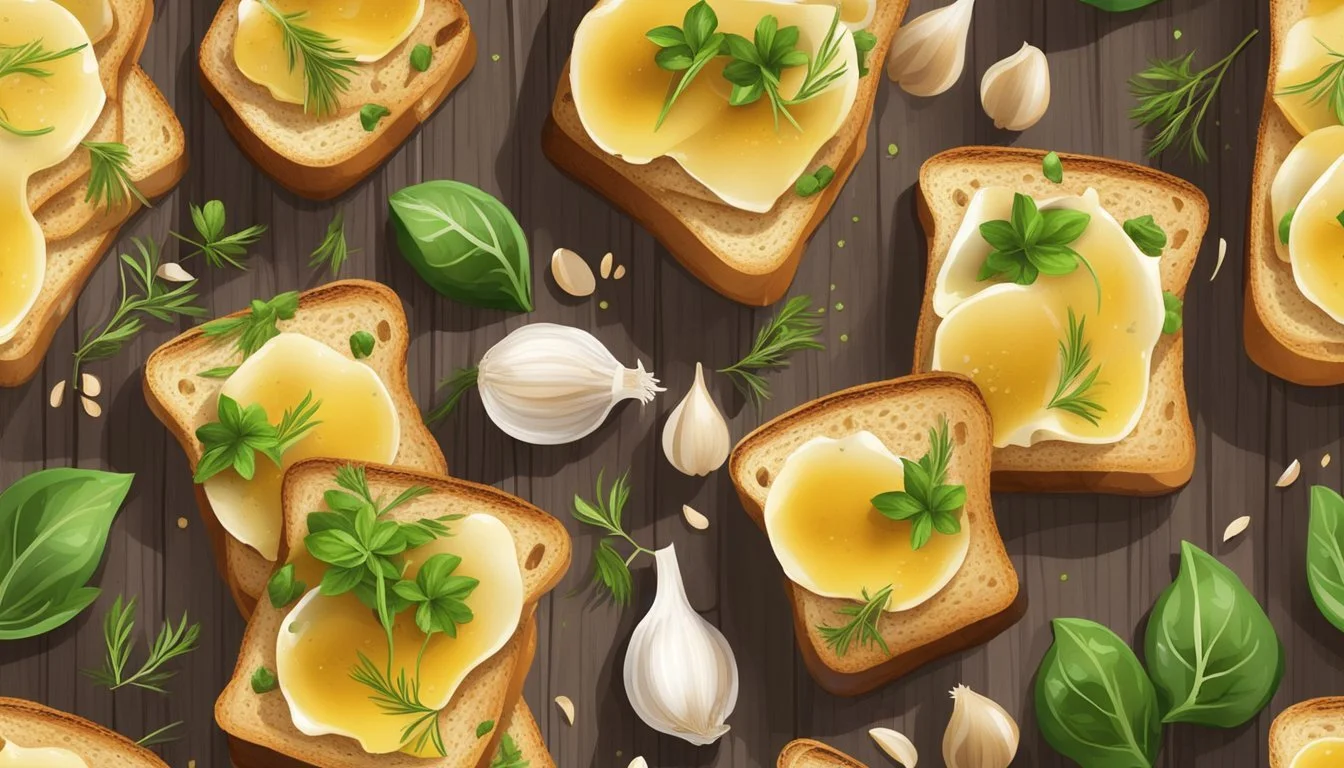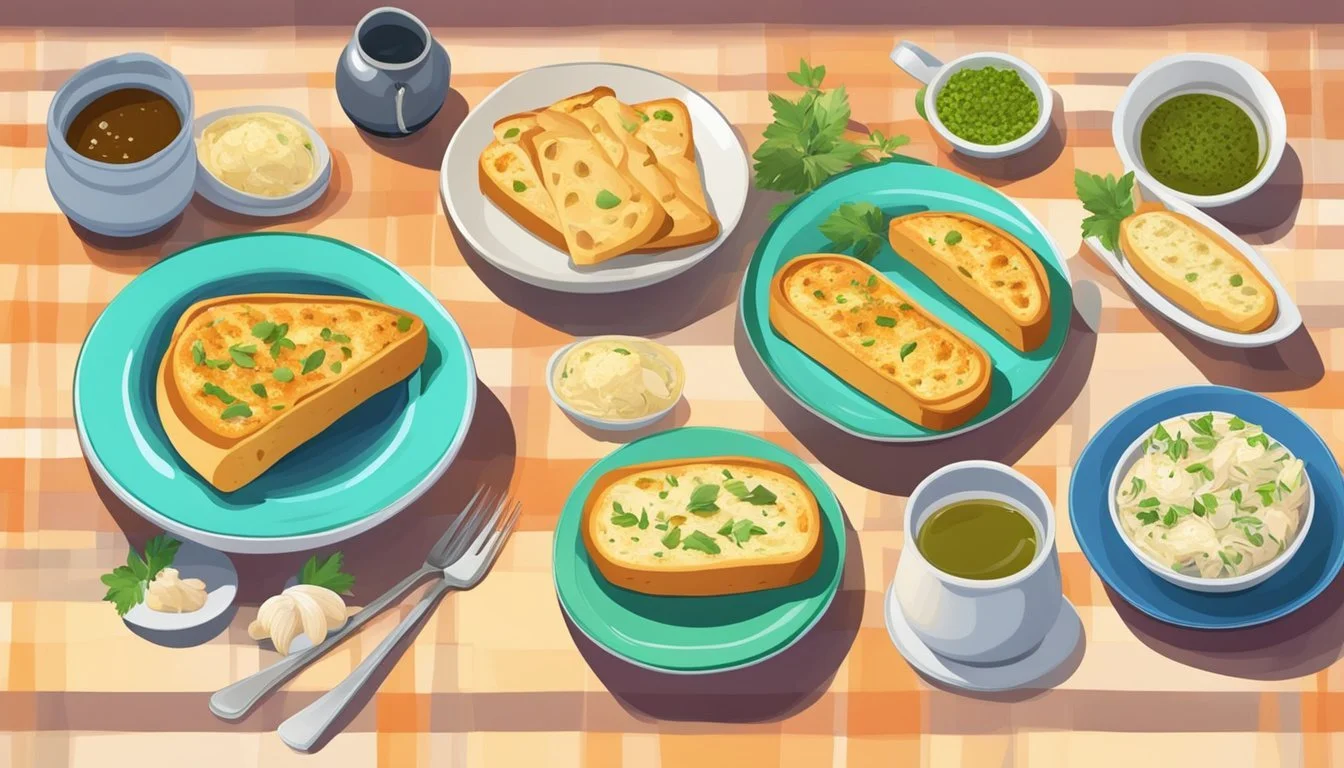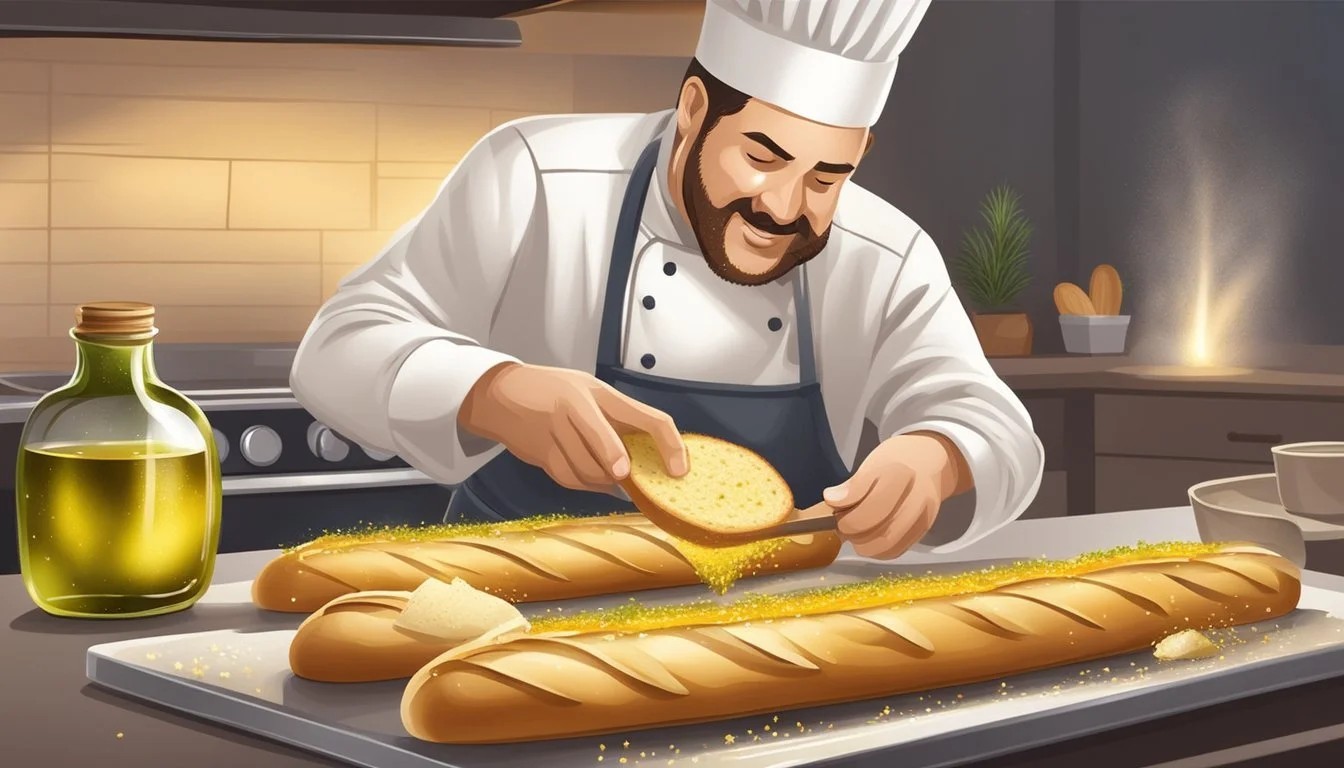Garlic Bread Substitutes
Tasty Alternatives for Your Favorite Side
Garlic bread is a beloved side dish enjoyed by many for its rich flavor and satisfying crunch. However, dietary restrictions or personal preferences often necessitate finding alternatives. These substitutes not only cater to various dietary needs but can also add a new dimension to your culinary experience. From whole grain options to vegetable-based sides, there are numerous ways to enjoy the essence of garlic bread without the traditional loaf.
Many alternative recipes focus on incorporating the key flavors of garlic bread – garlic, herbs, and a touch of saltiness – into different foods. Whole grain bread can provide a healthier foundation, while a roasted garlic spread offers a lower-carb option with a similar taste profile. For those looking to incorporate more greens into their meals, kale chips seasoned with garlic can be a surprisingly delightful replacement offering a nutritious crunch. Each substitute aims to complement dishes just as classic garlic bread would, making them versatile additions to any meal.
Understanding Garlic Bread
Garlic bread is a beloved side dish known for its rich, savory flavor that complements an array of meals, especially pasta dishes. The essence of garlic bread lies in its simple, yet flavorful, composition typically involving a base of bread, such as a baguette or Italian loaf, which is sliced and then infused with a garlic flavor.
This flavor is most commonly introduced through a mixture of butter and minced garlic, spread onto the bread. The butter not only carries the garlic flavor but also provides a satisfying richness and helps achieve a golden-brown crust when baked. Olive oil can be used as an alternative to butter, offering a different flavor profile and making the dish suitable for those who prefer a dairy-free option.
Garlic is the star ingredient and can vary in form from freshly minced to a more subdued roasted variant, depending on the desired intensity of the garlic flavor. The prepped bread is then traditionally baked until it reaches the perfect balance of crispy edges and a soft, warm center.
To enhance its taste and visual appeal, garlic bread is often garnished with herbs such as parsley or oregano. Here's a typical breakdown of garlic bread components:
Base: Typically a crusty baguette or Italian loaf
Fat: Butter for richness, or olive oil for a lighter version
Seasoning: Minced or powdered garlic, herbs, and sometimes cheese
Texture: Baked for a crispy exterior and soft interior
The immense popularity of garlic bread stems from its comforting texture and the universally appealing combination of garlic and butter or oil, which has secured its place as a staple in many households and restaurants.
Essential Ingredients
When crafting substitutes for garlic bread, the ingredients chosen play a pivotal role in the flavorsome outcome of the dish. Selecting the appropriate type of bread, variety of garlic, and fat choice can enhance the dish while adhering to dietary preferences or restrictions.
Types of Bread
The foundation of any garlic bread substitute begins with the choice of bread. Whole grain breads are often recommended as a healthier alternative to traditional white loaves, due to their enhanced fiber content and nutritional value.
Whole Grain Bread: Provides a denser texture and nutty flavor.
Gluten-Free Bread: Catering to those with gluten sensitivities without compromising taste.
Varieties of Garlic
Garlic—whether fresh or as a prepared product—imparts the distinctive flavor that's emblematic of garlic bread. Each form offers a different intensity and depth of flavor.
Garlic Cloves: When roasted, they offer a milder, sweeter taste.
Minced Garlic: A convenient option, delivering a more immediate and robust flavor.
Fat Choices
The type of fat used can transform the caloric content and health profile of garlic bread substitute recipes, while also influencing the texture and taste.
Butter: While traditional, it can be high in saturated fats.
Olive Oil: A heart-healthy fat that provides a distinct Mediterranean flavor.
Garlic Oil: Infused oils can deliver a double punch of garlic flavor and are ideal for those avoiding dairy.
Popular Garlic Bread Substitutes
When searching for a garlic bread substitute, individuals often seek alternatives that accommodate dietary restrictions or offer lower calorie options. The following substitutes provide a range of choices that cater to gluten-free needs, calorie-conscious diets, and a desire for a herb-infused flavor.
Gluten-Free Alternatives
For those avoiding gluten, Cauliflower bread presents an excellent substitute. This gluten-free option mimics the texture and heartiness of traditional garlic bread with fewer calories. A homemade cauliflower bread can be seasoned with garlic paste for an enhanced flavor.
Low-Calorie Options
Kale chips stand out as a low-calorie alternative to garlic bread. When baked and seasoned with minced garlic, they capture the essence of garlic bread while being significantly lower in calories. This crispy, crunchy option is not only lighter but also adds a nutritional boost to one's meal.
Herb-Infused Substitutes
Substitutes that infuse herbs offer a flavorful twist to the classic garlic bread. One can prepare gluten-free bread slices with a spread made from roasted garlic cloves, olive oil, and mixed herbs such as oregano or parsley. This combination ensures the substitute is not only aromatic but loaded with flavor.
Creative Recipes for Garlic Bread Alternatives
Recognizing the need for healthier options that still satisfy cravings for garlic bread, the following recipes offer flavorful alternatives that explore diverse ingredients, from leafy greens to cruciferous vegetables.
Garlic-Flavored Kale Chips
Ingredients:
Kale leaves
Olive oil
Garlic powder or minced garlic
Salt and pepper to taste
Instructions:
Preheat oven to 375°F (190°C) and line a baking sheet with parchment paper.
Wash and dry kale leaves, then tear them into bite-size pieces.
Toss kale with olive oil and garlic until evenly coated.
Season with salt and pepper, and spread out on the prepared baking sheet.
Bake until crispy, about 10-15 minutes, monitoring to prevent burning.
Garlic-flavored kale chips provide a crunchy, nutrient-rich experience that emulates the garlicky kick of traditional garlic bread.
Cauliflower 'Breadsticks'
Ingredients:
1 head of cauliflower
1 egg (optional)
Shredded cheese (for binding and taste, optional for vegan)
Garlic powder or minced garlic
Salt, pepper, and herbs to taste
Instructions:
Preheat oven to 425°F (220°C) and place parchment paper on a baking sheet.
Rice the cauliflower by pulsing it in a food processor until it resembles grains.
Cook the cauliflower, let it cool, and then squeeze out as much moisture as possible with a towel.
Combine cauliflower with egg, cheese, and seasonings, then shape into breadstick-form on the baking sheet.
Bake until golden brown and set, approximately 25 minutes.
Cauliflower 'breadsticks' serve as a low-carb substitute, offering a satisfying texture and flavor that accommodates a variety of dietary preferences.
Roasted Vegetable Medley
Ingredients:
Assorted vegetables (e.g., zucchini, bell peppers, onions)
Olive oil
Garlic powder or minced garlic
Salt, pepper, and additional herbs to taste
Instructions:
Preheat oven to 400°F (200°C) and line a baking sheet with parchment paper.
Chop vegetables into chunks and place in a bowl.
Toss with olive oil, garlic, and preferred seasonings until well-coated.
Spread vegetables in a single layer on the baking sheet.
Roast for 20-30 minutes, or until tender and caramelized, stirring occasionally.
A roasted vegetable medley offers a delightful combination of flavors and textures that stand in well for garlic bread, providing a vibrant and healthful side dish to any meal.
Condiments and Toppings
When searching for substitutes to complement your bread of choice, one must pay attention to the art of condiments and toppings. These flavorful additions help transform any simple bread into a savory treat reminiscent of classic garlic bread.
Homemade Garlic Spread
For those who enjoy the essence of garlic bread, a homemade garlic spread is a convenient solution. One can mix softened butter with minced garlic, a dash of garlic powder, and a sprinkle of garlic salt. For added zest, incorporating a bit of grated Parmesan cheese can elevate the profile.
Olive Oil and Herb Drizzle
An olive oil and herb drizzle serves as a lighter but equally aromatic alternative. Combine extra virgin olive oil with a selection of herbs such as parsley and oregano. A squeeze of fresh lemon juice can also be a tangy addition. Drizzle this mixture over your chosen bread for a Mediterranean-inspired twist.
Cheese and Seasoning Combinations
Cheese and seasoning combinations are a way to add depth of flavor. Start with a base of mozzarella or Parmesan cheese, which pairs excellently with a sprinkle of sea salt and cracked black pepper. This blend gives an indulgent, savory characteristic to any bread substitute.
By choosing the right condiments and toppings, one can easily emulate the beloved flavors of garlic bread and provide a delectable side dish to any meal.
Health Benefits and Nutritional Considerations
When considering healthy alternatives to traditional garlic bread, one should focus on options that lower unhealthy fat and calorie content, boost dietary fiber and essential nutrients, and cater to specific dietary needs or allergies.
Reducing Fat and Calories
Traditional garlic bread can be high in fats, especially if made with butter or margarine. Alternatives that use olive oil instead of butter can significantly reduce saturated fats while providing heart-healthy monounsaturated fats. A tablespoon of olive oil contains about 120 calories and 14g of fat, compared to butter with about 100 calories and 11g of saturated fat per tablespoon.
Increasing Fiber and Nutrients
Garlic bread made from refined flour is low in essential nutrients. Healthy alternatives that utilize whole grains can offer more fiber, promoting digestive health and helping to prevent heart disease. Adding vegetables such as kale or other green leafies as toppings or substitutes can increase the vitamin, mineral, and fiber content. For example, a 3.5-ounce serving of raw kale provides approximately 2 grams of fiber along with vitamins A, C, and K.
Allergies and Dietary Restrictions
People with dietary restrictions, such as those requiring gluten-free options or with sensitivities to certain ingredients, can benefit from substitutes for traditional garlic bread. Options like garlicky tortillas made from gluten-free flours or vegetable-based options can accommodate these needs while providing additional protein and nutrients beneficial for the immune system without compromising flavor.
Cultural Variations of Garlic Bread
Garlic bread has evolved globally, adopting flavors and presentation styles that reflect the culinary traditions of each region. These cultural variations maintain the dish's beloved elements of garlic and bread while introducing unique tastes and ingredients.
Italian Bruschetta
Bruschetta, often hailed as the Italian ancestor of garlic bread, typically starts with a sliced French baguette or Italian ciabatta. These slices are then topped with an assortment of fresh ingredients. Key to bruschetta is the combination of ripe tomatoes and basil, enlivened by a vibrant dressing of extra virgin olive oil and, of course, minced garlic. The unique taste of bruschetta reflects the simplicity and freshness central to Italian cuisine.
French Baguette with Herbs
The French have their own twist to garlic bread, utilizing the ubiquitous French baguette as a base. This version is less about garlic and more about the herbs. Parsley, thyme, and sometimes a hint of lavender are mixed with softened butter, spread generously on the baguette, and baked until golden. This subtler variation emphasizes the aromatic quality of herbs with a light garlic presence.
Indian-Inspired Garlic Naan
Branching further from traditional garlic bread, this Indian-inspired rendition uses naan, a leavened flatbread, as its foundation. Naan is often infused with garlic and brushed with ghee, offering a richer and softer alternative to the Italian and French versions. Some variations include a pinch of hing (asafoetida), which adds a unique taste reminiscent of giant fennel, lending it a distinct, slightly pungent flavor that complements the garlic.
Pairing with Dishes
Garlic bread is a versatile side that complements a variety of main courses. Its rich flavor pairs excellently with the depth of soups and stews, the lightness of salads and appetizers (What wine goes well with appetizers?), and the hearty robustness of pasta and sauces.
Soups and Stews
When one serves garlic bread alongside soups and stews, they enhance the meal's heartiness and offer a textural contrast to the dish. Beef or chicken stew pairs well with garlic bread, allowing the flavors to meld together.
Beef Soup: A robust beef soup with a tomato base is perfect for combining with garlic toast.
Vegetable Stew: For a vegetarian option, a rich vegetable stew with legumes complements the buttery garlic profile.
Salads and Appetizers
Garlic bread can transform a simple salad or appetizer into a more fulfilling dish.
Salads: An Italian salad with crisp greens and a tart vinaigrette creates a balance against the savory garlic bread.
Appetizers: Bruschetta is a great choice, where diced tomatoes and basil on toast create a refreshing start to any meal.
Pasta and Sauces
Pasta dishes are a classic pairing for garlic bread, especially when accompanied by rich, tomato-based sauces.
Eggplant Parmesan: This dish, featuring breaded eggplant with tomato sauce and melted cheese, is an ideal vegetarian option.
Pasta e Fagioli: A traditional pasta and bean soup offers a comforting blend with garlic bread, melding with its texture and flavor.
Alternative Ingredients for Garlic
When seeking a substitute for fresh garlic, several options can provide similar flavor profiles while catering to different culinary needs.
Garlic Powder and Granules
Garlic powder is dehydrated ground garlic, offering a milder taste compared to fresh garlic. It is suitable for dishes where a more subtle garlic flavor is desired. The ratio for substitution is typically 1/4 teaspoon of garlic powder for every clove of fresh garlic required.
Bold for emphasis:
Garlic granules resemble coarser garlic powder and can be used in a similar fashion, adjusting the measurements accordingly to match the potency of fresh garlic.
Onions and Shallots
Onions and shallots can impart a similar pungency to garlic but with additional sweetness. For each clove of garlic, one can substitute the following:
Onions: Use 1 tablespoon of chopped onion.
Shallots: Slightly milder and more refined, 1 tablespoon of chopped shallot works well.
Italic for additional options:
Chives offer a more delicate option, while fennel provides a unique anise-like taste which can complement many recipes where garlic is required.
Herbs and Spices
A variety of herbs and spices can mimic the complex flavors of garlic. Here are specific substitutes:
Hing (Asafoetida): A pinch can replace a clove of garlic, offering a similar umami flavor.
Ginger: It does not replicate garlic's flavor, but it brings a complimentary warmth to dishes.
List for organization:
Herbs that work well as garlic flavor enhancers or substitutes include:
Basil
Oregano
Thyme
For those avoiding salt, it's important to note that garlic salt is a mix of garlic powder and salt and should not be used as a one-to-one substitute for garlic if sodium intake is a concern.
Baking and Cooking Techniques
Achieving the perfect garlic bread substitute involves precise baking and cooking techniques, ensuring both flavor and texture are spot-on. These methods accentuate the aromatic profile and satisfy the craving for that classic garlic bread taste.
Using a Baking Sheet
A baking sheet is the foundation for preparing garlic bread substitutes. It offers even heat distribution and a flat surface ideal for making Garlicky Tortillas or toasting slices of whole grain bread. Here’s how to optimize its use:
Preparation: Align the baking sheet with parchment paper or a silicone baking mat to prevent sticking and achieve a uniform crust.
Arrangement: Space the tortillas or bread evenly on the sheet to allow for proper heat circulation.
Temperature: Preheat the oven to 375°F for tortillas or whole grain bread to ensure a crispy texture.
Toasting Methods
To capture the essence of garlic bread, toasting is a critical step. Whether using a traditional toaster, oven, or stovetop, here are techniques to consider:
Oven Toasting: Arrange the bread on a preheated baking sheet and toast until the edges are golden-brown.
Stovetop Toasting: For a crispier alternative, toast bread in a skillet over medium heat, pressing down lightly to enhance browning.
Bread Type: Whole grain bread can be a healthier option, serving as a robust base for garlic flavors.
Flavor Infusion Techniques
Flavor is the soul of garlic bread, and substitutes should be infused with a rich garlicky taste. Employ these infusion techniques:
Garlic Preparations: Use minced jarred garlic, dried garlic flakes, or garlic juice for varied intensity. Garlic chives can add a fresh, herbaceous layer.
Application: Generously brush the substitute with a mixture of olive oil and garlic. This mimics the traditional garlic butter spread.
Seasonings: Sprinkle a pinch of sea salt and black pepper to balance and elevate the garlic profile.
By meticulously applying these baking and cooking techniques, one can create substitutes for garlic bread that are not only comparable in taste but also offer a delightful texture.
Storing and Preserving Garlic Bread Substitutes
Effective storage and preservation methods are crucial for maintaining the flavor and texture of garlic bread substitutes. These methods ensure that the substitutes are enjoyable long after they have been made.
Freezing and Reheating Methods
Freezing: Substitute items like granulated garlic, dehydrated garlic, or garlic powder can easily be stored in a freezer. They should be kept in airtight containers or heavy-duty freezer bags to maintain freshness. Frozen garlic items can last for up to 12 months without significant loss of flavor.
Whole Grain Alternatives: Whole grain bread slices can be frozen with toppings for later use. Freeze individually on a baking sheet before transferring to a container or freezer bag. Reheat in a 350°F oven until warmed through, usually 10 to 15 minutes.
Tortillas: Garlic-flavored tortillas can be cut into quarters and frozen in a single layer. To reheat, bake directly from frozen at 375°F until crisp.
Reheating:
From Refrigeration: If refrigerated, gently reheat at a lower temperature wrapped in foil.
From Frozen: Items should be reheated in an oven preheated to 350°F. Reheating times may vary based on the thickness of the bread or substitute.
Drying and Dehydrating Options
Drying:
Homemade Garlic Flakes: Slice garlic thinly and dry in an oven at a low temperature until crispy. Store in an airtight container.
Dehydrating:
Kale Chips: Bake kale leaves at low heat after seasoning with garlic powder until completely dry. Store in an airtight container to maintain crispness.
For both drying and dehydrating:
Items must be completely free of moisture to prevent mold.
Store in a cool, dark place to extend shelf life.










